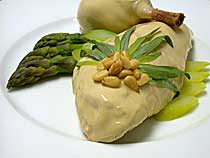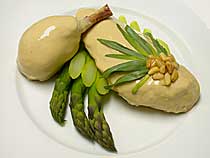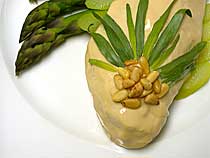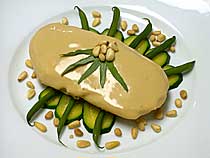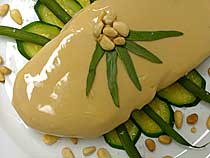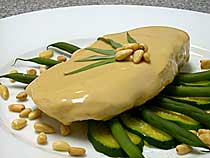 There’s a picture on page 253 in the 1996 edition of Larousse gastronomique that has always intrigued me. The picture is of a cream-colored serving plate with a central object that appears to be a boneless, skinless chicken breast coated with a thick layer of white icing. The breast is decorated with a few fresh herbs and served with some leafy salad greens and a sprinkling of pine nuts. Besides being a very nice photograph, the dish looks quite appetizing to me.
There’s a picture on page 253 in the 1996 edition of Larousse gastronomique that has always intrigued me. The picture is of a cream-colored serving plate with a central object that appears to be a boneless, skinless chicken breast coated with a thick layer of white icing. The breast is decorated with a few fresh herbs and served with some leafy salad greens and a sprinkling of pine nuts. Besides being a very nice photograph, the dish looks quite appetizing to me.
The first few times I ran across this picture, I simply admired it. Then I noticed that almost every time I opened this 1215-page tome, the book seemed to open to this picture. A phenomenon that I attribute more to the way the signatures are bound in the book than to some cosmic effect. Although I noticed the caption printed alongside the picture, Chaud-froid de poulet, salade de pourpier et de roquette, I never bothered to delve deeper into the underlying recipe. Recently that changed. My curiosity could no longer let me ignore the picture.
The picture and its accompanying recipe are part of a section simply labeled chaud-froid, which literally means warm-cold. The source of the term chaud-froid and when it was first used is a bit cloudy. I have three different editions of Larousse gastronomique and each tells a slightly different story.
The most plausible seems to be the one offered by Philéas Gibert (1857-1942). In 1759, the Maréchal de Luxembourg was hosting a banquet near Paris at the Château de Montmorency. Just as the festivities were about to begin, the Maréchal was summoned to the King’s Council. He ordered that the banquet proceed in his absence. When he returned, long after the banquet had finished, he asked for one dish. This dish was a chicken fricassee whose ivory-colored sauce had long since congealed around the meat. The Maréchal apparently liked this cold concoction so much that he requested it again a few days later. The dish was presented under the moniker of refroidi, but the Maréchal ordered that the name on the menu be changed to chaud-froid.
There is an alternative group of historians that believes the preparation dates back to Roman times. In the 19th century excavations at Pompeii, a jar was discovered that contained fragments of meat packed in aspic. The jar was inscribed calidus-frigidus, which can be translated as chaud-froid.
Because recipes for this type of preparation don’t appear in print until the beginning of the 19th century, the first explanation sounds more plausible. But whatever their origin, the popularity of chaud-froid preparations seems to have peaked at the end of the 19th century or the beginning of the 20th. Today, these dishes are practically non-existent.
Grimod de la Reynière (1758-1837) mentions a chaud-froid de bécasse in his 1808 Manuel des amphitryons. Prosper Montagné (1865-1948), in the original Larousse gastronomique, quotes a recipe from Marie Antonin Carême (1784-1833) in Le Pâtissier parisien for chaud-froid de poulet à la gelée and there may have been others in the same book. Carême’s five-volume L’Art de la cuisine française au dix-neuvième siècle seems to be devoid of any chaud-froid recipes. In the middle of the 19th century, both Urbain Dubois (1818-1901) in La Cuisine classique and Jules Gouffé (1807-1877) in Le Livre de cuisine provide numerous examples of chaud-froid dishes. In the early years of the 20th century, Auguste Escoffier (1846-1935) in Le Guide culinaire and Ali-Bab (1855-1931) in Gastronomie pratique also provide many examples. By mid-century when Curnonsky (1872-1956) published Cuisine et vins de France, only one chaud-froid recipe is included. Raymond Oliver (1909-1990) revived interest in these dishes briefly in his 1967 book La Cuisine, but that may be the last great cookbook to include classic chaud-froid preparations.
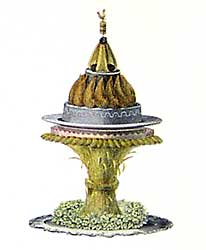 In its classic preparation, a chaud-froid dish consists of cooked poultry that is cooled and then coated with a jellied white or brown sauce. The final dish is served cold. Although Dubois describes eight different recipes for sauce chaufroix, all the preparations can be divided into those made from sauce espagnole (brown) or sauce velouté (white). In each case the master sauce is augmented with gelatin to cause it to solidify better at room temperature. The individual sauces are either used as is or supplemented with other ingredients, like truffles, blood, artichoke purée, tomatoes, herbs, and such. The poultry is cooked, skinned and partially boned, cut into serving pieces, and coated with the sauce. Dubois was known for his “architectural” creations. For his chaufroix, the coated pieces of meat would be arranged in a structural form and further decorated with other ingredients. Although preparations for small birds often started with a dozen or more whole carcasses, Dubois also created preparations made from just the breasts or tenderloins of the birds.
In its classic preparation, a chaud-froid dish consists of cooked poultry that is cooled and then coated with a jellied white or brown sauce. The final dish is served cold. Although Dubois describes eight different recipes for sauce chaufroix, all the preparations can be divided into those made from sauce espagnole (brown) or sauce velouté (white). In each case the master sauce is augmented with gelatin to cause it to solidify better at room temperature. The individual sauces are either used as is or supplemented with other ingredients, like truffles, blood, artichoke purée, tomatoes, herbs, and such. The poultry is cooked, skinned and partially boned, cut into serving pieces, and coated with the sauce. Dubois was known for his “architectural” creations. For his chaufroix, the coated pieces of meat would be arranged in a structural form and further decorated with other ingredients. Although preparations for small birds often started with a dozen or more whole carcasses, Dubois also created preparations made from just the breasts or tenderloins of the birds.
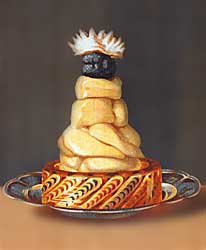 Gouffé presents similar presentations to those of Dubois. In addition, he presents a chaud-froid of fruit intended to mimic his chaud-froid de poulet à la gelée in appearance. Apples are used to represent the chicken breasts and are coated with blanc-manger instead of a white chaud-froid sauce.
Gouffé presents similar presentations to those of Dubois. In addition, he presents a chaud-froid of fruit intended to mimic his chaud-froid de poulet à la gelée in appearance. Apples are used to represent the chicken breasts and are coated with blanc-manger instead of a white chaud-froid sauce.
The recent versions of Larousse gastronomique, both in French and English, include game, meat, and fish in their general descriptions of chaud-froid preparations, but only include a salmon recipe to serve as an example. In this case, the sauce used for the coating is the poaching liquid, a well-seasoned fish stock. There’s no mention of augmenting the sauce with gelatin.
But what about that original recipe that attracted me to this subject? After reading and considering many, many chaud-froid recipes in books from the last 250 years, I decided to try the recipe that accompanied the picture that originally caught my eye. The recipe is as follows:
I followed the recipe very closely, cooking the chicken the night before I was planning to serve it and finishing the dish the following afternoon, except I served it with a different vegetable. The preparation went well from start to finish. The finished dish can be seen in the following photographs.
From the start, I was concerned about the length of time that the chicken would be cooked. One hour seemed like a long time to poach a chicken, especially since it is served cold and the meat tends to harden when chilled. My concern turned to reality and the finished chicken, although it looked nice, was so overcooked that I found it almost inedible. But since the rest of the preparation went well, I decided that I would try to make the dish again, but cook the chicken differently.
I decided to borrow from the century-old recipes and make the sauce as a separate preparation from the cooking of the chicken. I made the sauce from glace, cream, gelatin, egg yolk, and lemon juice. Instead of using a whole chicken, I used just boneless, skinless breast. The chicken was roasted instead of being poached. (There are poaching and steaming methods used in Chinese cooking that would also work well with this recipe.) The results were quite good. The chicken was tender and juicy and the coating was rich and flavorful. I think the second attempt, as shown below, turned out just as visually pleasing as the first. The final recipe follows the pictures.
Chaud-froid de poulet
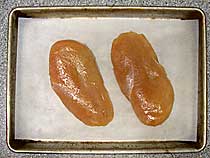 Skin the chicken breast. Carefully remove the large fillets from the breast. Remove the tenderloins from the fillets and reserve for other purposes. Trim the narrow ends of the fillets so their shape is similar at both ends. Trim any ragged protrusions from the edges of the fillets. The smoother the edges of the fillets, the smoother the final coating will be.
Skin the chicken breast. Carefully remove the large fillets from the breast. Remove the tenderloins from the fillets and reserve for other purposes. Trim the narrow ends of the fillets so their shape is similar at both ends. Trim any ragged protrusions from the edges of the fillets. The smoother the edges of the fillets, the smoother the final coating will be.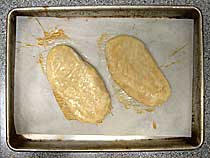 Season both sides of the fillets with fine salt. Place the fillets, skin side up, on a parchment paper-lined baking sheet. Roast the fillets for 4 minutes. Flip the fillets over and continue to roast them until their internal temperatures reach 52 °C (125 °F), about 4 minutes more. Cover the fillets with another baking sheet and set aside to rest until the meat cools. When the meat is cool, transfer it to a plate, cover the plate with plastic wrap, and refrigerate very well, such as overnight.
Season both sides of the fillets with fine salt. Place the fillets, skin side up, on a parchment paper-lined baking sheet. Roast the fillets for 4 minutes. Flip the fillets over and continue to roast them until their internal temperatures reach 52 °C (125 °F), about 4 minutes more. Cover the fillets with another baking sheet and set aside to rest until the meat cools. When the meat is cool, transfer it to a plate, cover the plate with plastic wrap, and refrigerate very well, such as overnight.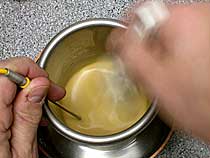 Place the sauce container in the ice-water bath and chill, stirring continuously, until the sauce begins to thicken, which happens when its temperature lowers to about 20 °C (68 °F). If the sauce thickens too much, it will start to get lumpy. If this occurs, place the sauce container in the hot-water bath and continue to stir until the sauce is smooth again. It will only be a few degrees warmer but much thinner. Move the sauce container back to the ice-water bath and chill again only until it starts to thicken.
Place the sauce container in the ice-water bath and chill, stirring continuously, until the sauce begins to thicken, which happens when its temperature lowers to about 20 °C (68 °F). If the sauce thickens too much, it will start to get lumpy. If this occurs, place the sauce container in the hot-water bath and continue to stir until the sauce is smooth again. It will only be a few degrees warmer but much thinner. Move the sauce container back to the ice-water bath and chill again only until it starts to thicken.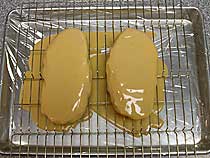
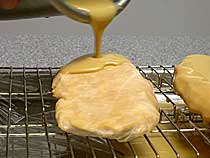 Starting with the thick end of each fillet, carefully and slowly pour the sauce over the fillets until evenly coated. Because the fillets are cold, the sauce should start to solidify almost as soon as it contacts their surface. When the fillets are evenly coated, place the baking sheet in the refrigerator until the coating is fully jelled, which should take only a few minutes. Leave the extra sauce out at room temperature for use as “glue” in decorating.
Starting with the thick end of each fillet, carefully and slowly pour the sauce over the fillets until evenly coated. Because the fillets are cold, the sauce should start to solidify almost as soon as it contacts their surface. When the fillets are evenly coated, place the baking sheet in the refrigerator until the coating is fully jelled, which should take only a few minutes. Leave the extra sauce out at room temperature for use as “glue” in decorating.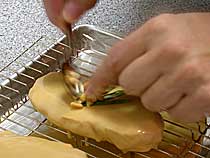
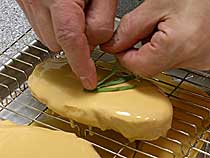 Decorate the breasts with tarragon leaves and pine nuts. The leaves can either be used raw or they can be briefly blanched and patted dry. Arrange the tarragon leaves on the surface of the breasts. Put a few drops of sauce on the breasts where the pine nuts will be placed. Carefully place the pine nuts into the sauce to “glue” them in place. Place the baking sheet back in the refrigerator to solidify the attachment of the nuts.
Decorate the breasts with tarragon leaves and pine nuts. The leaves can either be used raw or they can be briefly blanched and patted dry. Arrange the tarragon leaves on the surface of the breasts. Put a few drops of sauce on the breasts where the pine nuts will be placed. Carefully place the pine nuts into the sauce to “glue” them in place. Place the baking sheet back in the refrigerator to solidify the attachment of the nuts.Yield: 2 servings.
©2005, 2014 Peter Hertzmann. All rights reserved.
